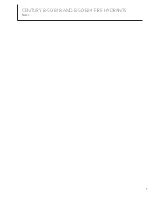
4
CENTURY, B-50-B18 AND B-50-B24 FIRE HYDRANTS
Installation, Operation, Inspection and Maintenance
joint of existing nozzle and re-pouring and caulking
joint for new nozzle. Resilient sealed nozzle may be
replaced using kit available from Mueller Canada.
If leakage through drains has been noted with hydrant
in open position, drain lever washers should be
replaced. (See directions for removal of internal parts.)
If hydrant does not drain or drains very slowly, the
drains should be flushed. Remove a cap and open
hydrant so barrel fills with water. Replace cap. Open
the hydrant valve approximately two turns. This
unseats the hydrant valve and allows the hydrant
barrel to be pressurized while still holding the drain
open. Check for proper drainage.
Lubricate nozzle cap threads with No.1 multi-purpose
grease. Since the bearing housing is sealed with O-
rings, it is not normally necessary to grease the
operating head.
Century Hydrants
– Drive cover pins through cover
into bearing housing and lift cover over operating nut.
Cover pins can be easily removed from clearance hole
in bearing housing and re-used.
REMOVAL OF INTERNAL PARTS
IF REMOVAL OF INTERNAL parts is required, the fol low -
ing sequence must be followed:
• Shut off water in line leading to hydrant.
• Open hydrant valve.
• Remove cover.
• Cover is held in place by bonnet pins. Remove pins and
lift cover over operating nut.
• Remove housing bolts.
• Remove complete housing (operating nut, housing
cover, thrust bearing and housing) as a unit by
continuing to turn operating nut in opening direction
until hydrant rod threads are disengaged. Carefully lift
complete housing from hydrant to prevent damage
to O-rings.
• Place seat wrench over the rod. Turn to left
(counter-
clockwise)
to unscrew hydrant seat from drain ring.
• Remove seat wrench from hydrant rod.
• Lift out hydrant rod with completely assembled work -
ing parts attached.
• Before threading hydrant seat into drain ring, lubri -
cate threads and face of seat gasket lightly.
• To re-assemble, reverse above procedure.
Non-Draining Hydrants
– Non-draining (plugged)
hydrants should be clearly identified. Unauthorized
use of non-draining hydrants can result in damage or
may render the hydrant inoperable – additional
supervision of these hydrants is required during
freezing conditions.
Slight valve leakage on non-draining hydrants can
result in damage and/or inoperable hydrants.
It is advisable to check non-draining hydrants for
water in the barrel several hours after the initial
inspection and pump-out has been completed.
Proper Drainage
– Close hydrant and remove a
nozzle cap. Drainage rate should be sufficiently rapid
that a suction can be felt when palm is placed over
nozzle opening.
Check for presence of water in the hydrant barrel by
using a plumb line or other suitable method.
NOTE: Water in the barrel of a non-draining
hydrant is an indication of leakage in the area of
the main valve and complete servicing of hydrant
will be required.
Water in the barrel of a drain type hydrant is an
indication of obstructed drain passage or a high
water table condition. Note condition and proceed
with inspection – if drains are verified to be
functioning properly, consideration should be
given to converting hydrant to non-draining type.
MAINTENANCE
If needed, add grease by removing the lubricating screw
in the top of the operating nut (do not use excessive
greasing pressure).
Replace any damaged caps, chains, etc., as noted on
inspection of external condition. If hydrant requires
painting, this should be done after all maintenance
has been completed.
If valve leakage has been noted, valve rubber and seat
gasket should be inspected and replaced if damaged.
(See directions for removal of internal parts.) Replace
any defective cap gaskets.
With "Leaded-In" type nozzles, a heavy blow on a
nozzle cap may cause loosening of the nozzle. If
leakage has been noted at the leaded joint, remove
cap and re-caulk nozzle. If nozzle has been damaged,
"Leaded-In" type can be replaced by melting out lead
Содержание B-50-B18
Страница 7: ...7 CENTURY B 50 B18 AND B 50 B24 FIRE HYDRANTS Notes...
Страница 8: ......


























